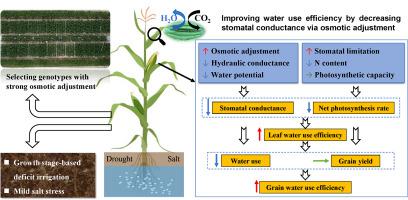Science of the Total Environment ( IF 9.8 ) Pub Date : 2021-09-16 , DOI: 10.1016/j.scitotenv.2021.150364 Qi Liao 1 , Shujie Gu 1 , Shaozhong Kang 1 , Taisheng Du 1 , Ling Tong 1 , Jeffrey D Wood 2 , Risheng Ding 1

|
Water and salt stress often occur simultaneously in heavily irrigated arid agricultural areas, yet they are usually studied in isolation. To understand the physiological bases of water use efficiency (WUE) of field-grown maize (Zea mays) at multi-scales under combined water and salt stress, we investigated the joint effects of water and salt stress on physiology, growth, yield, and WUE of two genotypes (XY335 and ZD958). We measured leaf stomatal conductance (gs), net photosynthesis rate (A) and hydraulic traits, whole-plant growth and water use (ET), and final biomass and grain yield. Leaf osmotic adjustment was a key trait of the physiological differences between XY335 and ZD958 under water and salt stress. Although the responses of the two genotypes were different, mild water and salt stress improved intrinsic water use efficiency (iWUE = A/gs) by (i) decreasing gs via increasing osmotic adjustment and hydraulic resistance, and (ii) declining A via increasing stomatal limitations rather than reducing photosynthetic capacity. Joint water and salt stress had a synergistic effect on reproductive growth and grain formation of maize. Mild water and salt stress reduced ET, stabilized grain yield, and improved grain WUE via declining gs, maintaining photosynthetic capacity, and improving harvest index. Collectively, our study provides a novel insight into the physiological mechanisms of WUE and demonstrates an approach for the efficient management of water and salt by using a growth stage-based deficit irrigation strategy or/and selecting genotypes with strong osmotic adjustment capacity and high harvest index.
中文翻译:

轻度水分和盐分胁迫通过调节渗透压降低气孔导度来提高田间玉米的水分利用效率
在灌溉严重的干旱农业区,水和盐胁迫经常同时发生,但它们通常是单独研究的。为了了解水盐胁迫下多尺度田间玉米(Zea mays)水分利用效率(WUE)的生理基础,我们研究了水盐胁迫对生理、生长、产量和两种基因型(XY335 和 ZD958)的 WUE。我们测量了叶片气孔导度 ( g s )、净光合作用速率 ( A ) 和水力性状、全株生长和水分利用 ( ET),以及最终的生物量和谷物产量。叶片渗透调节是 XY335 和 ZD958 在水和盐胁迫下生理差异的关键特征。尽管两个基因型的反应是不同的,轻度水分和盐分胁迫提高固有水分利用效率(IWUE = 阿/克小号通过)(ⅰ)降低克小号 通过增加渗透调节和液压阻力,和(ii)下降通过甲增加气孔限制而不是降低光合能力。水盐联合胁迫对玉米生殖生长和籽粒形成有协同作用。温和的水和盐胁迫降低了ET,通过降低g s、保持光合能力和提高收获指数来稳定粮食产量并提高粮食 WUE 。总的来说,我们的研究提供了对 WUE 生理机制的新见解,并展示了一种通过使用基于生长阶段的亏缺灌溉策略或/和选择具有强渗透调节能力和高收获指数的基因型来有效管理水和盐的方法.

























 京公网安备 11010802027423号
京公网安备 11010802027423号